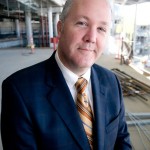Aviation
King of the Air(port) 
We sit down with Robert Gleason, chairman of the Airport Authority, to see what’s up with all that construction and when we’ll start hearing about relocation again.
By Randy Dotinga
When Robert Gleason gets a text message on his phone, it might be a complaint from a friend about inadequate customer service. But it’s not likely to have anything to do with his job as chief financial officer of Evans Hotels, a chain of three local luxury resorts.
Instead, Gleason often hears from his pals who are annoyed by problems at the airport, like broken lights or trash cans that need to be emptied.
Such is life for the chairman of the San Diego County Regional Airport Authority, which oversees Lindbergh Field, aka San Diego International Airport.
Tough gig? Gleason says he’s actually willing to hear the gripes of just about everyone who has an opinion about the region’s major airport, which happens to be just about everyone. (Not least of all that peeved guy who became a national hero when he told a Lindbergh security agent to not touch his “junk.”)
Not that Gleason will necessarily join in any negativity. His sunny personality and optimism may leave you brimming with a sense of the airport’s promise instead of griping about its long lines, cramped terminals and messy traffic.
In an interview, Gleason talked up the massive “Green Build” project at Terminal 2, explained why things soon won’t cost so much and promised a better experience for hungry and line-averse travelers. He also put up with questions about a few of my personal peeves.
Among other things, the airport is busy expanding and renovating Terminal 2 to allow the airport to handle more flights and planes. What on the horizon will change how we experience the airport?
Our mandate is to improve the experience throughout the airport.
For example, the Green Build, which includes 10 new gates. They’ll come with expanded seating areas and a much bigger security screening area along with more types of concessions for food, beverage and retail. And there will be a double-level roadway in front of Terminal 2 where you will arrive below and depart above, like at other airports. There will also be a significant curbside check-in area.
In Terminal 2 East, which is mostly American Airlines, we’ll be increasing the seating areas and the concessions options. And the parking will be back in front of Terminal 2.
At the same time, we’re doing other improvements overall. At the end of this year, we’ll be expanding the number and variety of offerings on the food, beverage and retail side. We’ll have a lot more local flavor. You’ll see Phil’s BBQ, Warwick’s books, a KPBS store, Pannikin coffee, Ryan Brothers coffee.
Will the airport ever give passengers a break in terms of $5 bottles of water and other jacked-up prices?
The new concessions are restricted to street pricing plus 10 percent. That means a cup of coffee here from Peet’s will be no more than it is at an off-airport location plus 10 percent. You will see significant changes.
What about Terminal 1, where Southwest is based? It can be aggravating since many of the restaurants are outside the secured area. That means you — and by you, I mean me — risk getting stuck in a long security line, potentially missing your flight if you take time for a bite to eat.
Right now, 70 percent of concessions are pre-security, which is a remnant of pre-9/11 construction. With both the opening of the new Green Build project and a reconfiguration of all of the rest of the concessions, 80 percent of those options will be post-security as of next year.
Terminal 1 is cramped, compared to the much more roomy Terminal 2, and has the food-before-security problem. Why renovate Terminal 2 first?
What we’re doing is building 10 entirely new gates, adding capacity.
Will we ever return to the good old days when incoming passengers could walk across the street in front of baggage claim to shuttle buses and their cars without having to deal with any annoying pedestrian bridge?
The pedestrian bridges will still be at Terminal 2 and Terminal 1.
What about security lines? Will any of this affect their size?
What we can do is provide better, more efficient facilities to allow screening to take place faster. In the new portion of Terminal 2, the security area will be twice as big and greatly expanded in terms of the lanes available. It will be for all of the terminal.
What about how I sometimes get confused in Terminal 1 if my Southwest flight is at gate 1 or 2 and I end up going in the wrong security line? Could you put up some signs just for me?
How about if we provide an escort? (Laughs.)
That would be awesome!
So the airport is working on creating a consolidated car rental facility, like some other airports have, by 2015. And there are other construction projects in progress. Does this mean talk of moving the airport is dead?
In 2006, voters very decisively said they did not want the airport moved to Miramar, which was the only viable option. Since then, the focus has been on making this airport work to the maximum extent possible.
This summer, we’ll start on the Airport Development Plan, a process which will last probably about four years. It will address what the development will look like at this airport for the next 20 years. It will talk about Terminal 1, the Teledyne Ryan site (on North Harbor Drive), which is now in the late stages of demolition and environmental remediation, and the airport’s capacity.
Passengers are often quite critical of Lindbergh Field, although they appreciate its convenient location, and it recently got an average rating from the J.D. Powers people. There must be plenty of passengers like me whose favorite part of the airport is the exit. Is it difficult for you personally when people like me say stuff like that and complain endlessly about travel hassles?
I love listening to the stories. I’ve experienced them too, and part of my job is to respond to the concerns, explain who might be responsible and see if we can work to improve things.
I am proud of this organization, its staff and its ability to work in a constrained environment, in terms of the physical and financial constraints. We are excited about where things are going.
The interview was first published in Voice of San Diego on March 2, 2012. Reprinted with permission. Interview conducted and edited by Randy Dotinga. Please contact Dotinga directly at randydotinga@gmail.com and follow him on Twitter: twitter.com/rdotinga.


